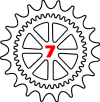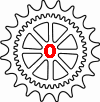|
Chain
(or belt) & sprocket wear influences

'Same
tooth - same link' chain rotations
Besides obvious factors for chain wear like not enough maintenance (i.e.
greasing it) and misalignment of sprockets and chain, the chain will
simply wear out more when it is used more. Especially if the same tooth hits the same link all the time the chain wears out faster than
when that tooth hits another link instead. Whether or not this will
happen depends on the combination of teeth and chain links. Three type
of combinations are possible:
1)
Worst: every chain rotation, the sprockets (front or rear or both) are
at the same position
2) Better: it takes more than one chain rotation for it to hit the same
tooth with the same link
3) Optimal: it takes the maximum number of chain rotations for it to hit
the same tooth with the same link
Table "Same
tooth - Same Link" shows what type of combinations you have or are
about to get. This by showing the actual number of chain rotations and
marking them red for 'Worst', not marked for 'Better' and marked green
for 'Optimal'.
Number
of contacts
Another factor that influences the chain wear is of course the
number of contacts a tooth has with links and the other way around for
the chain, the number of contacts a link has with teeth. The more hits,
the faster the wear ! So obviously, the more you use your bike, the more
the final drive will wear out. Changing the final drive does not
make you use your bike more or less, it just changes the use of the
final drive when driving the same distance as before.
That is
also why changing the rear sprocket, say bigger, wears out the front
more when driving the same distance .....
Therefore the table "Tooth-Links
contacts & Link-Teeth contacts" shows the number of contacts between
teeth and links, for every driven mile or kilometer.
Next:
Optimal teeth-links combination
Back to Gearing
Commander main page |






